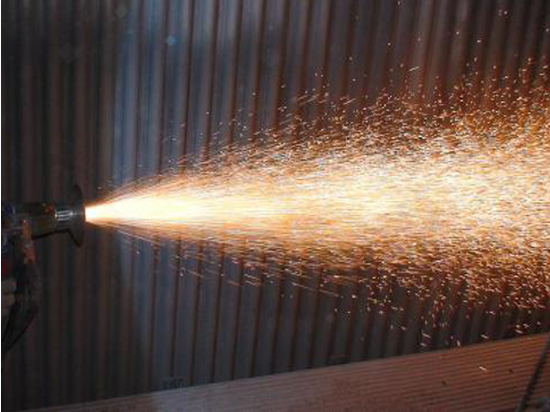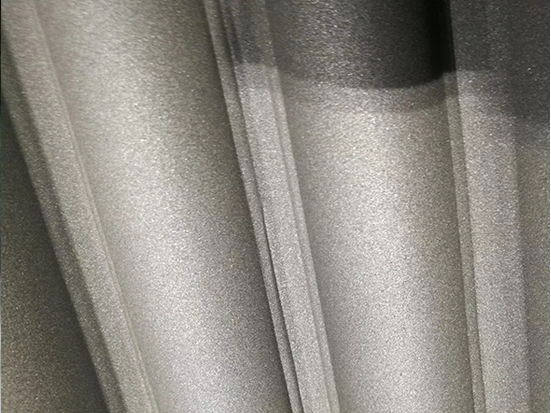

current position:Information and data>What are the advantages of boiler anti-wear spraying
Boiler anti-wear spray has the following advantages:
(1) The substrate is less heated, the parts are not deformed, and the heat treatment state does not change.
Since the parts are not charged and the base metal is not melted when the boiler is sprayed, although the temperature of the plasma flame is high, the energy is very concentrated, and the axial temperature gradient of the plasma arc is very large. Generally, the temperature rise of the parts does not exceed 200 °C, and the parts will not be deformed, which is very beneficial to the repair of thin-walled parts, slender rods and some precision parts. Since the heat treatment properties of the base metal will not change below 200°C, some high-strength steels can be sprayed. (2) The range of materials that can be sprayed is very wide, and there are many types of coatings.
Due to the high temperature of the plasma flame flow, various spray materials can be heated to a molten state, so there are many kinds of anti-wear spray materials for boilers, and spray coatings with various properties can be obtained, such as wear-resistant coatings, thermal insulation coatings, high temperature Antioxidant coating, thermal insulation coating, etc. In terms of the breadth of coatings, oxy-acetylene flame spraying, arc spraying, high-frequency induction spraying, and explosive spraying are not as good as boiler wear-resistant spraying. (3) The process is stable and the coating quality is high.
Boiler anti-wear spraying process parameters can be quantitatively controlled, the process is stable, and the coating reproducibility is good. In boiler anti-wear spraying, the flying speed of molten particles can reach 180 ~ 480 m/s or even higher, which is much higher than that of 45 ~ 120 m/s in oxygen-acetylene flame powder spraying. When the molten particles collide with parts When the deformation is sufficient, the coating is dense, and the bonding strength with the substrate is high. The normal bonding strength of boiler wear-resistant coating and base metal is usually 30 ~ 70 MPa, while the bonding strength of oxy-acetylene flame spraying is usually 5 ~ 20 MPa. Since the atmosphere can be controlled by changing the gas when the boiler is sprayed, the oxygen content or nitrogen content in the coating can be greatly reduced.
The process parameters of boiler wear-resistant spraying mainly include arc power, powder feeding amount, gas flow and spraying distance, spray gun moving speed, base metal temperature, etc. 1 Powder feeding amount and electric power
Powder feeding amount and electric power are more important parameters in the spraying process and need to be replaced frequently. Moreover, these two parameters are interrelated. When determining these two process parameters, it is critical to ensure that they are properly matched. The proper matching of powder feeding amount and power means that under different powder feeding amounts, different electric power should be applied to powder of a certain brand and particle size. The input power can be adjusted by adjusting the current. In the case of constant powder feeding, if the electric power is too small, the powder will melt poorly, and the coating will contain more raw powder, the powder will not be fully deformed when it hits the workpiece, and there will be more powder rebound loss. Resulting in low deposition efficiency and low coating quality. On the contrary, if the power is too large, although the melting and impact deformation of the powder are good, heating will make the powder seriously oxidize and ablate, there will be more soot in the coating, and the molten particles will splash seriously, which will also reduce the deposition efficiency and coating. quality. Therefore, for powder of a certain brand and particle size, the amount of powder delivered should be adapted to the electric power value. In production, the proper matching method of powder feeding amount and electric power is to use spray deposition efficiency test. In general, the electrical power value to the high point in the deposition efficiency curve is the preferred value.

2 spraying distance
It takes some time for the powder to be heated and accelerated in the plasma flame stream, so there should be a suitable spray distance. If the spraying distance is too close, the powder is poorly heated and the impact deformation is insufficient, which will affect the coating quality, and the parts will be severely oxidized by the plasma flame flow. If the spraying distance is too far, the powder that has been heated to a molten state will cool down when it comes into contact with the part, and the flying speed will begin to decrease, which will also affect the quality of the coating, and the spraying efficiency will drop significantly.
3 Flow of main gas, secondary gas and powder feeding gas
The gas that is introduced into the gun to compress the arc and ionize is called the primary gas. Ar gas is the main gas commonly used in boiler anti-wear spraying. In order to increase the enthalpy of the plasma arc, N2 and H2 are usually added to the ion gas, which is called secondary gas or secondary gas, and the gas used to drive the powder is called powder feeding gas. The main gas flow is one of the important process parameters, which directly affects the enthalpy and flow of the plasma flame flow, which in turn affects the spraying efficiency and coating porosity. If the flow is too large or too small, the spraying efficiency will decrease and the coating porosity will increase. If the gas flow is too large, the ion concentration will decrease, the excess gas will cool the plasma flame flow, reduce the enthalpy and temperature, which is not conducive to the heating of the powder, and the uneven melting of the powder will reduce the spraying efficiency, make the coating structure loose, and increase the porosity. On the other hand, if the air flow is too small, the working voltage of the spray gun will drop, which will weaken the flame flow and easily cause nozzle ablation. The flow rate of the powder feeding gas also has a great influence on the coating quality, especially the powder feeding spray gun. If the flow rate of the powder feeding gas is too small, it will be difficult for the powder to reach the center of the flame flow, while if it is too large, the powder will pass through the center of the jet flow, resulting in serious "boundary effect", which will loosen the coating and reduce the bonding strength.
2 spraying distance
It takes some time for the powder to be heated and accelerated in the plasma flame stream, so there should be a suitable spray distance. If the spraying distance is too close, the powder is poorly heated and the impact deformation is insufficient, which will affect the coating quality, and the parts will be severely oxidized by the plasma flame flow. If the spraying distance is too far, the powder that has been heated to a molten state will cool down when it comes into contact with the part, and the flying speed will begin to decrease, which will also affect the quality of the coating, and the spraying efficiency will drop significantly.
3 Flow of main gas, secondary gas and powder feeding gas
The gas that is introduced into the gun to compress the arc and ionize is called the primary gas. Ar gas is the main gas commonly used in boiler anti-wear spraying. In order to increase the enthalpy of the plasma arc, N2 and H2 are usually added to the ion gas, which is called secondary gas or secondary gas, and the gas used to drive the powder is called powder feeding gas. The main gas flow is one of the important process parameters, which directly affects the enthalpy and flow of the plasma flame flow, which in turn affects the spraying efficiency and coating porosity. If the flow is too large or too small, the spraying efficiency will decrease and the coating porosity will increase. If the gas flow is too large, the ion concentration will decrease, the excess gas will cool the plasma flame flow, reduce the enthalpy and temperature, which is not conducive to the heating of the powder, and the uneven melting of the powder will reduce the spraying efficiency, make the coating structure loose, and increase the porosity. On the other hand, if the air flow is too small, the working voltage of the spray gun will drop, which will weaken the flame flow and easily cause nozzle ablation. The flow rate of the powder feeding gas also has a great influence on the coating quality, especially the powder feeding spray gun. If the flow rate of the powder feeding gas is too small, it will be difficult for the powder to reach the center of the flame flow, while if it is too large, the powder will pass through the center of the jet flow, resulting in serious "boundary effect", which will loosen the coating and reduce the bonding strength.

4. Gun moving speed
The influence of the moving speed of the spray gun on the coating quality and spraying efficiency is not obvious within a certain range. The moving speed of the spray gun or the relative speed of the spray gun and the workpiece under a certain amount of powder feeding is slow or fast, which refers to the area of the workpiece or the thickness of each spray layer swept by the spray gun per unit time. Therefore, adjusting the moving speed of the spray gun actually It is to control the thickness of each sprayed layer. The thickness of each spray should not be too thick. Generally, the thickness of each spray coating should not exceed 0.25 mm, and it is better to spray a coating of more than 0.25 mm twice. In addition, the moving speed of the spray gun also affects the temperature rise of the workpiece. In order not to cause excessive thermal deformation or thermal stress due to the high local temperature rise of the substrate, it is also desirable to select a faster moving speed of the spray gun on the premise of ensuring coverage.
5. Base metal temperature
The temperature of the metal substrate is an important parameter of the spraying process. Most workpieces require preheating prior to spraying to remove moisture and activate the surface, facilitate the bonding of the coating to the substrate, and control the thermal expansion of the substrate relative to the coating. For some thin-walled parts, the stress caused by the inconsistent shrinkage of the parts and the coating during the cooling process after spraying can be reduced, which is beneficial to the combination of the coating and the substrate. Preheating before spraying can also reduce the drop in fatigue strength of parts after spraying. However, when the preheating temperature of the metal parts exceeds 200 °C, a serious oxide film begins to appear on the surface of the parts, resulting in a significant decrease in the bonding strength of the coating. The preheating temperature is generally 100~150℃. When spraying tungsten carbide cobalt powder, the temperature of the substrate should be kept low to reduce the burning loss of carbon.
Hot information

